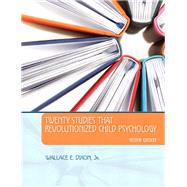For undergraduate courses in Child Development/Psychology, Life Span Development, Child and Family Studies, and Human Growth and Development
Twenty Studies That Revolutionized Child Psychology gives students a systematic look at the process of child psychology research by examining the twenty most revolutionary scientific investigations in the field over the course of the last fifty years. For the second edition, author and child psychologist Wallace Dixon polled an expanded number of experts in the field to determine the most important studies to be included. The result is an updated collection of revolutionary studies that helps students to better understand the discipline of child psychology.








